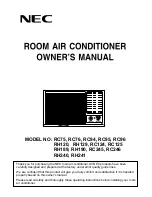
33
or if it is not possible to establish a priori the nature and extent of the maintenance operations to be
performed, it is necessary to proceed with the complete removal of the refrigerant gas and
reclamation, through a procedure called "flushing".
-
remove the refrigerant fluid by means of a vacuum pump, transferring it to suitable containers
(cylinders);
-
Add the inert gas (OFN: Oxygen Free Nitrogen) using the vacuum condition present, taking
care to check that all parts and components of the circuit are in a condition to receive the gas;
do not put the circuit under pressure with the inert gas, but return to atmospheric pressure
conditions;
-
Open the circuit in one or more points so that the inert gas can be exhaled externally;
-
Carry out the inert gas supply with the circuit open, in order to remove any traces of refrigerant
fluid still trapped inside.
The gas supply must be continued for a time that, depending on the flow of the aforementioned gas,
allows an overall "washing" of the inside of the circuit for 5 equivalent volumes.
At the end of this operation, maintenance activities can be carried out.
ATTENTION: INERT GAS OFN IS A NON-BREATHABLE FLUID (DANGER OF ASPHYXIA); THE
VENT IN THE ATMOSPHERE OF SUCH A FLUID MUST BE DONE AWAY FROM THE
OPERATOR.
6.7
Charging procedures
- Make sure that when using a refill equipment, contamination between different refrigerant fluids
does not occur. | flexible hoses or pipes must be as short as possible to minimize the amount of
refrigerant contained in them.
- The cylinders must be kept upright.
- Make sure that the refrigeration system is grounded before proceeding to recharge the system
with the refrigerant fluid.
- Label the system when charging is complete, (if not already done).
- Particular care must be taken not to overload the refrigeration system.
Before recharging, the system must be subjected to the pressure test with OFN. The system must
undergo a leak test at the end of charging but before putting it into operation. An additional leak test
must be performed before leaving the site.
6.8
Decommissioning
Before carrying out this procedure, it is essential that the technician is totally familiar with the
apparatus and all its details. It is good practice that all refrigerant fluids are safely stored. Before
carrying out the work, oil and cooling fluid samples must be taken in case an analysis is required
before using the cooling fluid again.
It is essential that electricity is available before starting work.
Before carrying out this procedure, it is essential that the technician is totally familiar with the
apparatus and all its details. It is good practice that all refrigerant fluids are safely stored. Before
carrying out the work, oil and cooling fluid samples must be taken in case an analysis is required
before using the cooling fluid again.
It is essential that electricity is available before starting work.
a) Become familiar with the apparatus and its operation
b) Isolate the system from an electrical point of view.
c) Before trying the procedure, make sure that
•
a mechanical manoeuvring device is available, if required, to handle the refrigerant
fluid cylinders;
•
all personal protective equipment is available and used correctly;
•
that the recovery process is constantly under the control of a competent person;
•
the recovery apparatus and the cylinders comply with the relevant standards.
d) Depressurize the cooling system, if possible.
e) If the vacuum cannot be obtained, connect a manifold so that the refrigerant fluid can be removed
from various parts of the system.
EN
















































